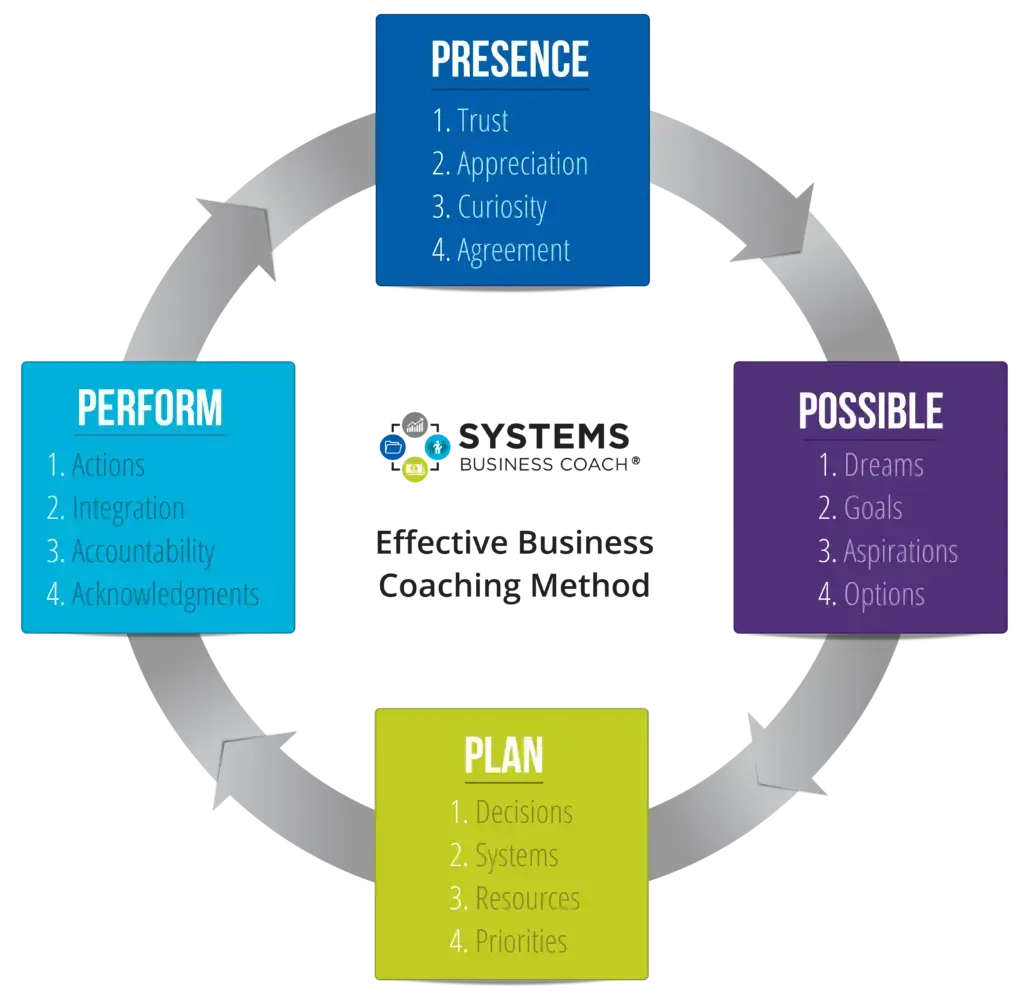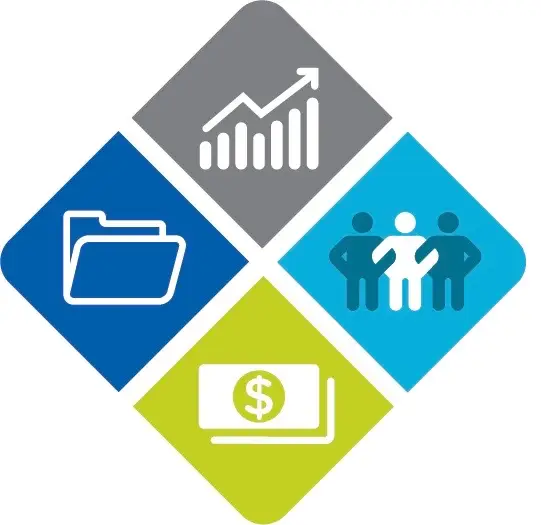How the Effective Business Coaching Method Aligns with ICF Core Competencies
Becoming an effective coach requires more than a passion for helping others. It demands a foundation of specific, observable skills that demonstrate a coach’s ability to hold presence, listen deeply, and guide meaningful progress.
At Systems Business Coach®, we align these core coaching skills with the Effective Business Coaching Method, a simple, structured way to navigate the coaching process while meeting the International Coaching Federation (ICF) standards for professional excellence.
The method includes four phases—Presence, Possible, Plan, and Perform—each representing a distinct mindset and set of skills that support the client’s growth. Whether you’re working with a small business owner, a manager, or a team, mastering these skills ensures that your coaching is ethical, practical, and effective.

Presence: The Foundation of Trust and Curiosity
Every successful coaching relationship begins with presence. Without it, even the most skilled questioning or planning falls flat. Presence means being fully engaged, grounded, and attentive to the client—listening not just to their words but to what they value, what they avoid, and what matters most.
In the Presence phase, the coach explores the client’s topic with them rather than assuming what’s important. This curiosity-driven exploration builds trust and invites partnership.
For example, a coach might begin a session with:
“What feels most important to focus on today?”
It’s a simple question, yet it signals respect for the client’s autonomy. From there, the coach and client reach agreement on what the client wants to accomplish in the session. Establishing this outcome together keeps the coaching focused and relevant.
Once the desired outcome is clear, the coach explores its significance—why it matters to the client. For instance:
“What would it mean for you and your business if this issue were resolved?”
Understanding significance connects the conversation to emotion and purpose, essential drivers for action.
Throughout the session, the coach attends to the agreed-upon agenda, gently bringing the client back when conversations drift. This keeps the dialogue purposeful while still allowing space for insight and reflection.
Being present also involves responding in real time to what the client brings forward—observing subtle shifts in tone or energy, staying curious, and allowing space for silence. New coaches often feel tempted to fill the quiet, yet silence can be the most powerful coaching tool. It gives the client time to process, reflect, and think.
Presence in Practice
Imagine coaching a small business owner who arrives frustrated about employee turnover. Instead of offering advice, the coach listens and reflects:
“It sounds like you’ve been carrying this concern for a while. What’s most pressing about it today?”
By acknowledging what’s said and felt, the coach validates the client’s experience without judgment. This creates safety—a space where authentic exploration can occur.
Presence also involves appreciation and agreement. When a client shares something vulnerable or insightful, the coach acknowledges the courage it takes to say it out loud.
“I can see how much thought you’ve put into this. It’s clear you care deeply about your team.”
That simple acknowledgment reinforces trust and partnership, core elements of any effective coaching relationship.
Possible: Helping Clients Discover What They Want Most
Once trust and curiosity are established, the conversation moves into what’s possible. This is where the client’s dreams, goals, aspirations, and options come into focus.
The coach helps the client explore not only what they want to achieve but also why it matters. This involves supporting the client’s expression of feelings, perceptions, and beliefs. Coaches acknowledge their client’s work in each session, expressing respect for the effort and thought they bring to the conversation.
For instance:
“You’ve done a lot of reflection on this issue. What stands out for you as the most important insight so far?”
Acknowledgment isn’t flattery—it’s recognition. It signals that the coach sees the client as capable and resourceful, not as someone who needs fixing.
The coach also invites exploration of emotions and perceptions that shape decision-making. Questions like:
“What concerns or assumptions might be influencing how you see this situation?”
or
“How do you feel about the changes you’re considering?”
These questions help clients uncover internal barriers and beliefs that influence behaviour. In small business coaching, this often surfaces in discussions about delegation, money, or confidence—areas where beliefs can strongly impact action.
Possible in Action
Consider a client struggling to expand their business. They may express fear of losing control or worry that growth will compromise quality. Rather than challenging those beliefs directly, the coach might ask:
“What would successful growth look like for you?”
“How might it be possible to grow and maintain your standards?”
By focusing on possibilities instead of problems, the coach opens space for new thinking. The conversation shifts from limitation to aspiration.
At Systems Business Coach®, this aligns directly with the Possible phase of our method—helping clients clarify their dreams, define meaningful goals, and explore the options available to them. It’s not about pushing the client toward an outcome; it’s about helping them see what’s possible when they take ownership of their direction.
Plan: Turning Insight into Structure
Once a client identifies what they want, the conversation turns to planning—deciding how to move forward. Here, the coach supports the client to organize ideas, identify priorities, and commit to specific actions.
In this phase, effective coaches demonstrate several key skills: listening for underlying meaning, confirming understanding, helping clients view situations from multiple perspectives, and asking open-ended questions that expand thinking rather than close it down.
For example:
“What are some different ways you could approach this?”
“What resources or systems would help you follow through?”
“What priority would you give this compared to your other commitments?”
These questions guide the client to move from ideas to decisions, building the foundation for effective action.
The coach also summarizes or paraphrases what the client has said to confirm understanding and clarify next steps:
“So, you’re saying that your main priority is improving communication with your team before expanding further. Did I get that right?”
Summarizing not only confirms clarity but also reinforces that the coach is listening deeply.
Plan in Practice
Imagine a business owner who’s realized through coaching that they need to delegate more. The coach helps them explore options—hiring, training, or restructuring roles—and then supports them in creating a plan.
The coach might ask:
“What would make it easier for you to let go of some of those tasks?”
“What systems could help ensure quality stays consistent as you delegate?”
This is where the Systems Business Coach® philosophy shines—pairing mindset with systems. A coach helps clients identify the structures that will support their decisions long after the coaching session ends.
By the end of the Plan phase, clients often have a clearer sense of their priorities, the resources they need, and the systems that will keep them on track. The coach doesn’t tell them what to do but helps them think through what works best for their unique context.
Perform: From Plan to Practice
The final phase of the Effective Business Coaching Method—Perform—is where insight meets action. Here, coaches support accountability, integration, and reflection, helping clients apply what they’ve learned and sustain progress over time.
A skilled coach doesn’t just ask what actions a client will take; they help the client reflect on what they’ve learned during the session and how that learning will shape future behaviour.
Questions might include:
“What have you learned about yourself today?”
“How will this insight influence how you lead your business this week?”
“What support or structure do you need to stay on track?”
These questions transform coaching from a one-time event into a continuous learning process.
Before closing the session, the coach acknowledges the client’s effort and growth:
“You’ve done some strong thinking today about delegation and trust. What’s your biggest takeaway?”
Acknowledgment here reinforces confidence and self-efficacy. When clients feel seen for their progress, they are more likely to act on their commitments.
Finally, the coach supports closure. Rather than abruptly ending, they help the client summarize what was accomplished and confirm next steps.
“So, your plan is to meet with your team next week to review responsibilities, and you’ll schedule a follow-up to assess how it’s working. How confident do you feel about taking that step?”
This intentional close ensures both clarity and momentum.
Integration: The Cycle Continues
Coaching is cyclical, not linear. Each Perform phase leads naturally back to Presence, as clients return with new insights, challenges, and opportunities. The Effective Business Coaching Method reflects this ongoing process of learning, applying, and refining.
Over time, these coaching skills—listening, curiosity, acknowledgment, perspective-taking, and accountability—become second nature. They are not mechanical steps but living practices that support the client’s transformation.
At Systems Business Coach®, we teach these skills not just as competencies to be checked off but as ways of being. They are grounded in trust, appreciation, curiosity, and agreement—qualities that define both effective coaching and ethical human interaction.
Examples of How These Skills Show Up in Small Business Coaching
1. Exploring Topics with Curiosity
A small business owner says, “My team isn’t following through.”
An inexperienced coach might jump into problem-solving.
A skilled coach explores:
“What does follow-through look like for you?”
“What might be getting in the way?”
“What do you think your team needs from you to succeed?”
This approach reveals insights about communication, systems, and expectations that would have been missed if the coach offered advice too soon.
2. Attending to the Agenda
Coaching conversations can wander. A skilled coach gently brings focus back to the goal.
“You mentioned earlier that your priority today was improving communication. How does this relate to that?”
This keeps sessions productive while respecting the client’s natural flow of thought.
3. Supporting Emotional Expression
When clients show frustration or uncertainty, a coach acknowledges it:
“It sounds like this situation has been really draining for you.”
This simple act of empathy often diffuses tension and builds deeper connection.
4. Asking Clear, Open Questions
Effective coaches ask one question at a time, allowing space for reflection:
“What do you want to see happen next?”
Rather than “Why haven’t you done it yet?”—which can sound judgmental—the coach invites forward-looking thinking.
5. Encouraging Reflection and Learning
Before ending a session, a coach helps clients reflect on what they’ve learned:
“What insight are you taking away from today’s conversation?”
This supports long-term change, not just short-term solutions.
Becoming a Certified Systems Business Coach®
Learning to demonstrate these minimum coaching skills takes time, practice, and support. New coaches often begin by focusing on techniques—how to ask better questions, how to summarize—but over time, they learn that coaching is less about doing and more about being.
Being present.
Being curious.
Being respectful.
Being accountable.
Through the Effective Business Coaching Method, these competencies come to life. They provide a structured yet flexible framework that guides both new and experienced coaches in supporting meaningful, measurable progress for their clients.
When a coach masters Presence, Possible, Plan, and Perform, they embody the very heart of professional coaching: the ability to create a space where people think deeply, act confidently, and grow sustainably.
Final Thought
For every new coach, the goal isn’t perfection—it’s practice. The more you apply these skills, the more natural they become. Whether you’re guiding a small business owner through a tough decision or helping a team realign around shared goals, your presence, curiosity, and respect set the stage for lasting change.
As you continue your journey, remember:
Coaching isn’t about knowing the answers.
It’s about helping others discover their own.
That’s the true power of the Effective Business Coaching Method—a method that transforms conversations, strengthens relationships, and helps build organized and profitable small businesses everywhere.









